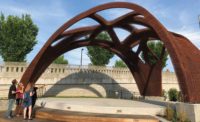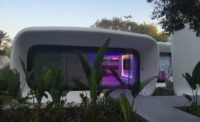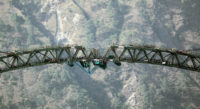A standard, industrial robotic arm has “printed” about a third of a 12-meter pedestrian bridge that is destined to span an old Amsterdam canal in the Netherlands as early as next year.
Led by local artist and designer Joris Laarman, a small team is using a digitally controlled welding process to built up elaborately shaped bridge elements in the Amsterdam workshop of the 3D-printing company MX3D.
All elements of the approximately 6-metric-ton, stainless-steel bridge should be fully formed and assembled by mid-2018 for full-scale testing, says Tim Geurtjens, the company’s chief technical officer and co-owner.
Geurtjens hopes the canal site will be ready to receive the whole bridge by the end of next year. But before that can happen, the structure needs to secure insurance coverage and approval by city officials.
“There is an issue, particularly with permitting. This is not a codified project,” says Mathew Vola, an associate director in the Amsterdam office of London-based Arup Group, which is advising MX3D. “There are no [other] 3D-printed bridges with this technique.”
Laarman’s team set up MX3D to use its software to form large-scale steel elements using standard welding techniques and robots, says Geurtjens. Having secured a site and backing from industrial partners, the team completed its design in May 2016.
The concept was “relevant for a bridge” but too complicated, Geurtjens concedes. “We found that structural engineering is now not ready for [such] complex geometries.”
The team’s construction advisers at Rosmalen-based contractor Heijmans N.V. used an analysis model that was “too simplified” for the “cool” structure they wanted, says Geurtjens. So, they brought on Arup late last year for a redesign.
MX3D’s initial bridge design “was made of trusses, much like a 3D space frame,” says Vola. That statically indeterminate structure, with high stress concentrations, added to other uncertainties, such as the material’s brittleness and fatigue performance.
So, Arup remodeled the bridge as a U-section channel that is curved in plan. The engineers developed and structurally analyzed the essentially 2D, folded plate using 3D parametric modeling software in a totally digital operation. “We don’t do drawing any more,” says Vola.
Although the team has done extensive theoretical work on the bridge, “there are a lot of unknowns about the material,” says Geurtjens.
MX3D is using Class 314 stainless steel, which has good performance at high temperatures. The welded product is less homogeneous than conventional steelwork, says Bertrand Le, an Arup engineer on the project. But its strength characteristics are the same as that of conventional steel, while the material is relatively free of in-built stresses.
Because of all the uncertainties, MX3D will validate its design with a full-scale prototype. Geurtjens is optimistic that the structure will secure the required permits next year.
If tests reveal the bridge needs reinforcing, “we can print extra parts,” says Geurtjens. And if all goes to plan, he adds, future structures will be printed entirely on site.








Post a comment to this article
Report Abusive Comment